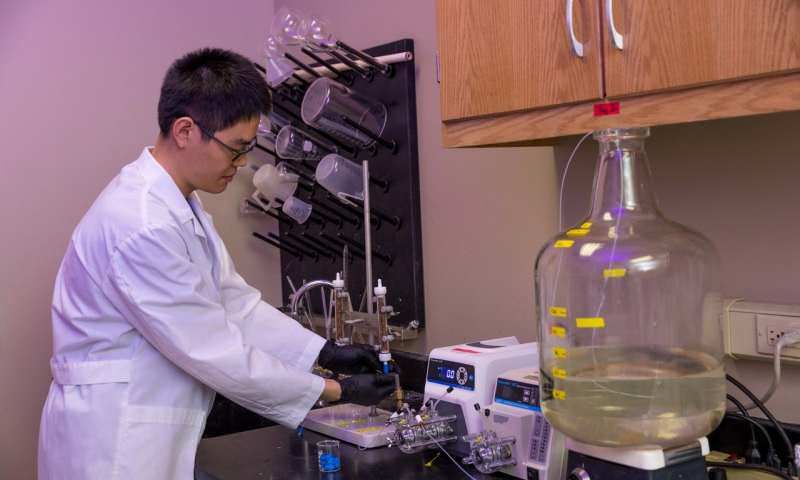Steel Chips Show Promise at Removing E. Coli from Storm Drain Water
Published on by Water Network Research, Official research team of The Water Network in Academic
A summer rainstorm can rejuvenate the landscape, but the runoff it creates may contain contaminants, such as E. Coli bacteria, that can negatively impact water quality in rivers and streams.
Peng Dai, a graduate student in the South Dakota State University Department of Civil and Environmental Engineering, is testing an inexpensive yet efficient means of removing E. coli from storm water runoff—steel chips.

Credit: South Dakota State University
"Storm water can carry human and animal waste into rivers and streams," said Dai, who completed his master's degree in May. His research adviser is assistant professor Guanghui Hua. The East Dakota and James River Water Development Districts and the U.S. Department of Transportation through the Mountain Plains Consortium funded the project.
E. coli contamination is one of the major water quality impairments of the Big Sioux River according to South Dakota Department of Environment and Natural Resources. Testing at several storm water drainage sites at Brookings showed that E. coli concentrations at these drainage sites after a summer storm can be as high as 2,000 colony forming units (cfu) per 100 milliliters (mL).
Hua explained that a previous graduate student had tested zeolite, limestone and steel slag, a byproduct of the mining industry, as well as steel chips. Those results led to Dai's study focusing on steel chips.
Small column testing showed carbon steel chips can remove anywhere from 85 to 98 percent of E. coli from simulated storm drain water, according to Dai. The steel chips tested are waste materials gathered from a Sioux Falls machine shop.
Dai examined steel chips ranging in size from 0.5 to 8 millimeter and used simulated storm water with E. coli concentrations of low (10 cfu/100 mL) to extremely high (106 cfu/100 mL) levels. He also evaluated the effect of pH levels 5, 7 and 9, as well as contact times of 5 to 20 minutes. "I controlled the nutrient levels in the simulated storm water so that the E. coli survived but did not multiply," Dai explained.
He found that the 0.5 to 2 mm chips worked best. In addition, "the longer the contact time, the better. At 20 minutes, the steel chips can remove nearly 99 percent of E. coli," Dai said. Although the lower pH produced better results, Dai recorded removal rates of at least 90 percent for all pH levels tested.
In addition to the continuous flow testing, Dai simulated intermittent storm water events in which water circulated for six hours, then the chips were dry for six hours, followed by six hours of flow. "They worked the same—the chips still keep a high efficiency removal rate," said Dai. His research provided the groundwork for another graduate student who is designing a filter for pilot-scale testing.
Hua has identified south Brookings site where storm water from a 10-acre residential area drains into a retention pond. "The structure, which looks like an open-top box, will be positioned at the inlet of the pond, so the storm water drainage passes through the steel media for E. coli removal." He anticipates having the structure in place this summer.
Source: South Dakota State University (Via Phys.org)
Media
Taxonomy
- Drinking Water Security
- Treatment
- Treatment Methods
- Drinking Water Treatment
- Sanitation
- Water & Sanitation
- Sanitation & Hygiene
- Drinking Water Managment
- Drinking Water
- water treatment
- Water Sanitation & Hygiene (WASH)